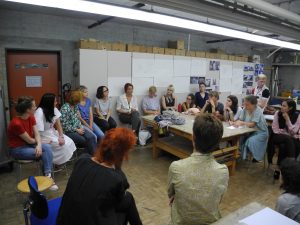
Together with the teachers of Kantonsschule Bülach
… or in the Zurich- or Sukhum group separately….
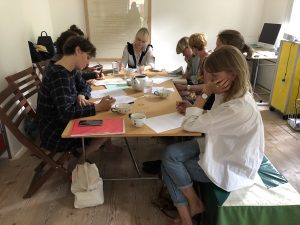
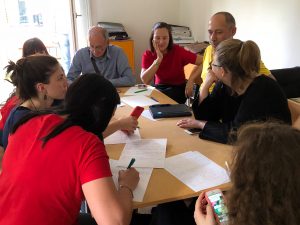
Switzerland & Southcaucasus

Together with the teachers of Kantonsschule Bülach
… or in the Zurich- or Sukhum group separately….


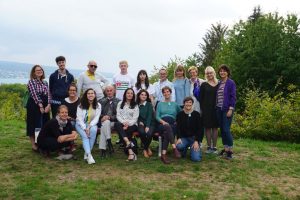
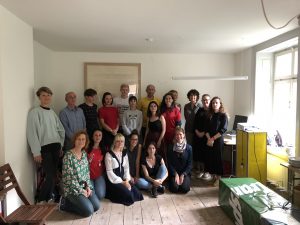
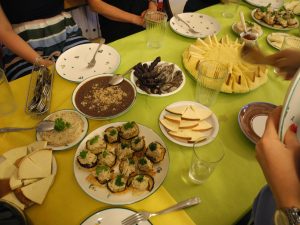
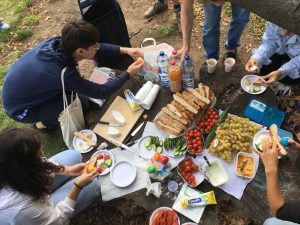
From a report about the workshop in Zürich and Bülach by Judit Villiger:
Die zwei Wochen ermöglichten Einblicke in kunstpädagogische Situationen auf der Sekundarstufe II in verschiedenen Institutionen. Durch die Zusammenarbeit mit den Fachschaften Bildnerisches Gestalten an den Kantonsschulen Zürich Nord (Oerlikon) und Zürich Unterland (Bülach) konnten die Teilnehmenden hospitieren und bekamen damit Einblicke in Doppellektionen, wie auch Einblicke in Aufgabenreihen über längere Zeiträume. Ein Besuch mit Führung an der Atelierschule Zürich und zwei museumspädagogische Führungen im Museum Rietberg und im Kunsthaus Zürich zeigten weitere Aspekte kunstpädagogischer Lehr-/Lernsituationen auf.
Im Austausch und der Reflexion in gemischten Gruppen, zusammengesetzt aus Teilnehmenden aus Abchasien/Georgien und der Schweiz, aus Dozierenden und Studierenden (ZHdK: Bachelor- und Master-Studiengang), sowie je einer Übersetzerin, wagten wir den Versuch, eigene Unterrichtseinheiten für die Stufe zu entwickeln, in welchen methodische Anteile aus beiden Systemen integriert werden sollten. Gemeinsame Runden im Plenum bei der abendlichen Zusammenkunft im Büro von artasfoundation (Leitung Dagmar Reichert) unterstützten den Austausch, der bei unserem Besuch diesen April in Suchum/i begonnen hatte. Wir versuchten damit weiter, Differenzen in kunstpädagogischen Vorannahmen auf den Grund zu gehen. So war es bereits bei unserm Besuch in Suchum/i den Studierenden der ZHdK eher ein Anliegen, Prozesse in Gruppen auszulösen, während die Kooperationspartner/innen den Lernerfolg in gelungenen, abgeschlossenen Einzelarbeiten der Schüler/Innen sahen.
Schon unsere unterschiedliche Herangehensweise an die Unterrichtsplanung legte Unterschiede zutage, welche namentlich implizite Lehr/Lern-Vorstellungen betrafen. Neben der sprachlichen Herausforderung – alles musste ins Russische und von da für uns wieder ins Englische übersetzt werden – stellten wir fest, wie wenig wir noch immer von den gegenseitigen ‘Lehrplänen’ wussten. Wir stellten fest, wieviel mitgemeintes Wissen ‘zwischen den Zeilen’ erst ausformuliert, nachvollzogen und in die je andere Kultur übersetzt werden muss, um uns eine gemeinsame Ausgangslage zu erschaffen. Die CH-Studierenden begriffen beispielsweise, dass die thematische Ideensuche, die ihnen als selbstverständliche Ausgangslage zum Vorbereiten erschien, alles andere als gegeben ist, wenn von Seiten der Kooperationspartner/innen Portraitzeichnen im akademischen Stil initiiert wird, wie es bei ihnen auf dem Plan steht. Wir fragten uns je länger je drängender, was wir voneinander wissen und lernen müssen, um überhaupt erst die Grundlagen zu legen, die es erlauben, in den Austausch kommen zu können.
Schliesslich unterrichteten alle Gruppen je 6 Doppellektionen Bildnerisches Gestalten an der Kantonschule Zürich Unterland in Anwesenheit der BG-Lehrpersonen, mit welchen die Unterrichtseinheiten im Anschluss reflektiert wurden. Die Gespräche indes sind noch lange nicht zu Ende, und auch der Austausch zwischen Suchum/i und Zürich scheint damit erst richtig begonnen zu haben: Die Studierenden und Dozierenden wünschen sich für eine nächste Phase, sich als Gruppen je gegenseitig zu unterrichten, um die System-Unterschiede, die Methoden-Ansätze, die Auffassungen möglicher Kunstbegriffe und das, was da alles ‘dahintersteckt’, möglicherweise noch besser und ‘am eigenen Leib’ erst zu erfahren. Wir haben immerhin gelernt, dass wir noch viel mehr voneinander wissen und voneinander lernen müssen, damit wir als disparate Gruppen erst handlungsfähig werden.
Through the support of the docent-team for Art Education of the Kantonsschule Bülach, in particular Priska Senn, the lectures could took place in different classes of this school. The participants of our workshop divided in three groups, all of them with participants from Zurich and from Suchum/i. Each group focused on a particular theme.
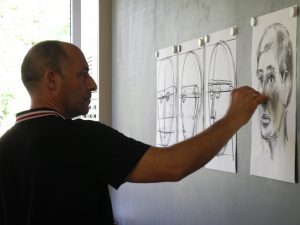
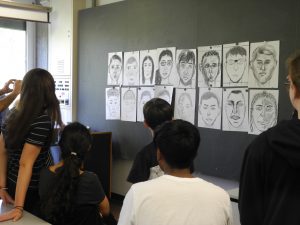
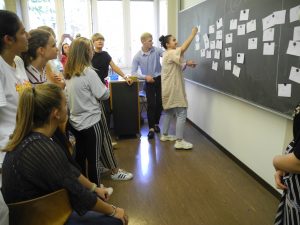 Group Nr. 1: Portraits
Group Nr. 1: Portraits
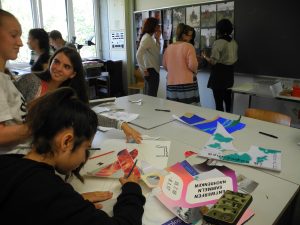
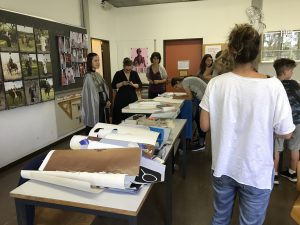
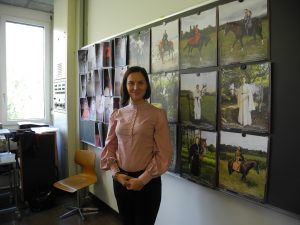 Group Nr. 2: Trad. & innovative dresses
Group Nr. 2: Trad. & innovative dresses
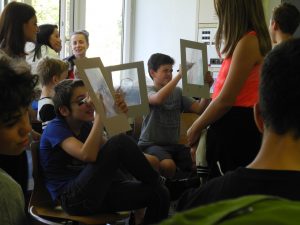
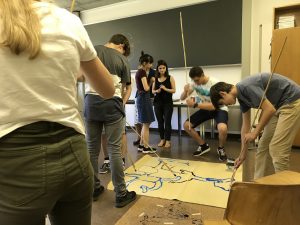
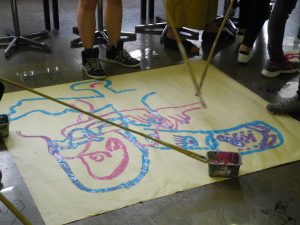 Group Nr.3: From small to large
Group Nr.3: From small to large
We arrived late in Suchum/i…. the sun, a red light ball above the horizon was setting slowly down, while we were sitting in the bus reaching Suchum/i by night. I remember being tired, but full of excitement. Where will it lead us to? Whom are we going to meet? What are we going to create together?
The next day at the University we were formally introduced, and finally met our students of exchange.
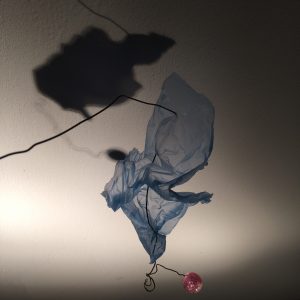
Our working group, we called it MOBILE, was very eager to create objects that where interesting to look at, or that gave an idea of a figure, or an association of cosmos and sky. The shadow became interesting, because it made our objects more dimensional. When the MOBILE was moving, the shadows of it, projected through the light were silently making a moving, light and two dimensional composition on the wall . It then revealed more of what we wanted to create: an appealing atmosphere in the room, that opened up associations, with little elements that could be looked at for a long time.
The open Sky at the seaside, as well as the found objects along the beach, were an inspiration to us.
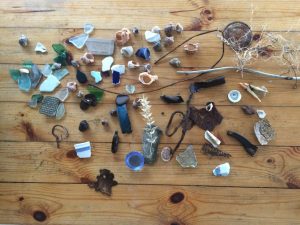
Without knowing which classes we are going to teach, we were talking a lot about how we could frame the topic so that we can be well prepared for many settings, and circumstances in school. Through reflecting we discovered the parallel of the story of Abkhazian Story Tachkum and the middle European fairy tale “the brave tailor” (Das tapfere Schneiderlein).
In both stories appears a traveller that meats a giant somewhere on his path. And to be able to pass, both Tachkum and the brave tailor have to proof their strength. They both trick the giant with a reddish cheese that they pull out from their pockets and squeeze it so hard that apparently liquid drops out of it. The Giant and the birds and flies are similar elements in both stories.
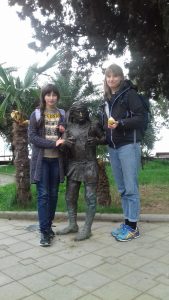
So from there we decided to slowly transform the classroom setting lesson by lesson, into a magical space with a lot of atmosphere, using the elements of the stories that where so similar in both tales.
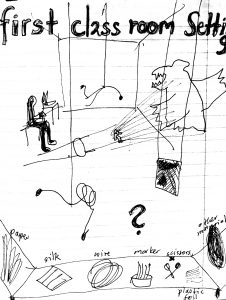
What was left from our ideas, and how we adapted ourselves to the surrounding.
Immediately when we entered the classroom, we had to teach a first lesson. So we were very much improvising, without any changes in advance. Nora was already writing about the birds, and the whistling sounds, which were very beautiful.
After the first reflection with our Art teacher and his class we adapted our program for the next day. We were told, that in April, the whole school has the cosmos, as an overall topic. We could watch a class the Teacher held. He draw the composition on the blackboard, and the children draw it similarly, with a personal note. So we decided together with the teacher, that the next day we bring in an input from our side, tackling the topic of the cosmos, but from a different angle with a different method. It was interesting that suddenly our MOBILE made very much sense. So we retook our first ideas and we arranged the room into an atmosphere that was different.
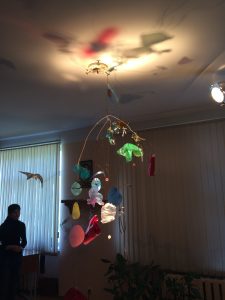
We wanted to create some wow effects for the children when they enter the room, that they immediately find themselves in a different “world”. The children should then, this was the plan, get inspired and come to their own interpretation of the cosmos and to their own compositions. And for that we changed seats and tables from their orientation to the front. We made a half circle, with space in the middle to come together and talk closer on eye to eye level.
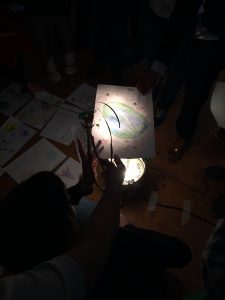
These classes, I do remember as harmonious. It seemed to me, that I saw many sparks of enthusiasm in the children’s eyes. And that we experienced some moments of wonder. The drawings of the children became very diverse and creative.
During these day and after a second reflection with the artteacher our lessons became much clearer and clearer. We integrated ideas from the artteacher and integrated elements of technical transfer. All in all, it was a rich, improvised, exchange and learning process in arts teaching, communication, intercultural dialogue and team work.
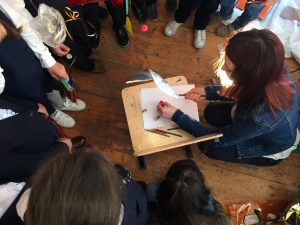
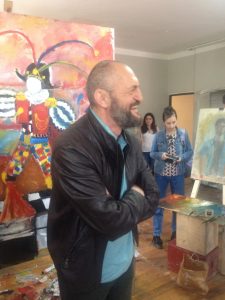 Painting Department, Art College, Sukhum/i
Painting Department, Art College, Sukhum/i
In the course of the discussions, it seemed to me that our discussion had assumed that there is a fundamental difference, when, in fact, there is a more gradual one: Also in education in Switzerland, at least as far as art education is concerned, it is necessary to know the techniques of screen printing, painting, and ceramics etc. In my view the difference in Swiss education lies in the practice, that the techniques follow a content much earlier in the institution’s curriculum. Both processes – learning a technique that can transmit a content, as well as reflecting about a content which a technique can realise – are conducted in parallel at the ZHdK. In this way, it seems to us, it is more likely to be able to rid oneself of technique in favor of a content in order to create a new content – a not insignificant circumstance when it comes to the horizon of creativity and ingenuity, which we consider an important medium of social action to be expanded.
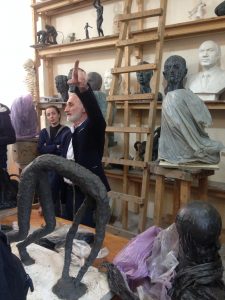 Sculpture Departement, Art College, Sukhum/i
Sculpture Departement, Art College, Sukhum/i
One question that often cropped up in conversations with the students and teachers from Sukhum/i was that of technique. In general, at least I understand, Sukhum/i’s academia assumes that first a basic technique has to be learned (building a figure, perspective, techniques of painting, sculpture, graphics …), before an individual can develop its personal talent. That means, ability is absolutely necessary to go beyond, whereas in Europe the opposite attitude has existed for some time.
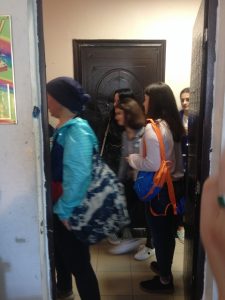 Art Academy Suchum/i
Art Academy Suchum/i
Due to this very comprehensible process, it seems urgent to invite the cooperation partner to be equally involved in the leadership of the Bülach part of the exchange. How / by what means this can be prepared, remains to be worked out. One possibility is to agree on a content and to work on each content with the resources available and the personal interests of each student. In this way, Sukhum/i and Zurich student’s familiar (academic) structures will begin to mix.
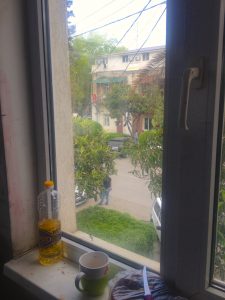 View form Sukhum/i’s Art College
View form Sukhum/i’s Art College
In the course of the process I try to describe, it became apparent that planning our collaboration in such a way that it left the initial starting point or subject open, resulted in exactly those hierarchical problems that one theoretically, in the honest conviction, sought to avoid: that there is always somebody who will take the lead. In most constellations, it was the students from Zurich who quickly drove the open process in a certain direction to get out of perplexity.
There were also structural reasons for this: The team from Zurich had already met several times, before the cooperation partners came along. And these came from different institutions. Equally strong was the fact that our cooperation partner lives in an isolated territory and was therefore open-minded, even wished for, something new – but actually we did as well!
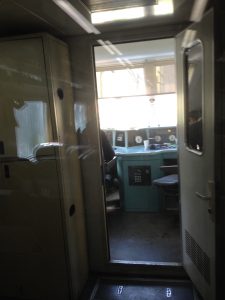
Most participants, including myself, appear one hour early for breakfast. – There was some annoyance in the air since yesterday – some students disagreed with the plan that we, the lecturers, tried to propose to them during our train journey from Tbilisi yesterday. To them, it seemed too strict, too abrupt, we were told. It was also criticized that a plan, as soon as it had arrived in our heads, would be hard to drop. In addition, and most importantly, the students thought, that an initial idea would leave the partners no space for their own proposals. They would be overrun, and that would be exactly the “colonial attitude” we normally would criticise. Some students expressed themselves less explicitly. Apparently we had been unable to convincingly communicate our concern.
In retrospect, however, it is clear to me that both sides were right, given their own horizon of experience. We lecturers had already collaborated with unknown partners many times, and always had found it beneficial to have an idea that could develop in the encounter. The students, on the other hand, were careful, and this was reasonable and cautious.
The Bridge Group
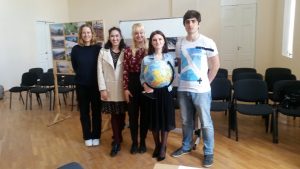
Our team in school number 10 formed quite quickly, already in the first week when we had to find materials. We found ourselves inspired by the idea of an Art Bridge. For us, a bridge could be the symbol that through art it is possible to connect people from all over the world. Just as we in the group experienced that we got to know each other through our joint interest and passion for art, we wanted to bring this feeling of friendship to our pupils in school number 10.
Even though we didn’t have as many pedagogical discussions as I expected in the beginning of this exchange, I still learned a lot about the way of teaching in Sukhum throughout our lessons. I was also a bit surprised that I didn’t have any other Swiss student from Art Education in my team. I would have liked that in order to have some exchange with more experienced students of my university. Anyway, I felt really comfortable in my team, and we felt that over time we became really good in working with each other. Everyone of us could speak openly about their wishes, criticism etc.
What is Switzerland?
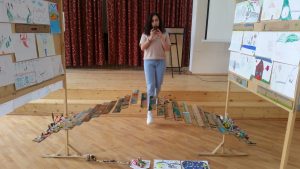
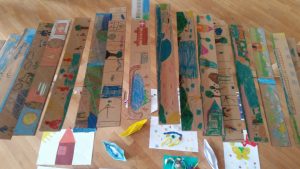
Our idea of the Art Bridge went through a big change, when we heard about the age of the pupils and the duration of the lessons. We only had 45 min per class (pupils were of an average age of 7 to 11). Unfortunately our ideas of the bridge couldn’t be realised in such short lectures, so we had to break them down to a certain minimum.
I am not sure if we, due to the short time in classes, were showing still a quite stereotypical view of these two places. But in order to keep up with the interest of the pupils in Switzerland it was important for us to keep the topic of the bridge and to do our best to not fall into stereotypical attributions. We tried to question the thoughts that the pupils have about the Swiss Alps and the Southern Caucasus, and also to show the similarities. We showed them similar pictures from both places as well as common music or legends. It was nice to see how engaged the pupils worked and how irritated they were, when the couldn’t distinguish the places anymore. The different classes had to draw, paint or create parts of the bridge, which we put together on the last day in order to create the Art Bridge of school number 10. I am happy with the results and I found it interesting when the pupils started to create something new, like a new place or a new legend.
Teaching and Improvising
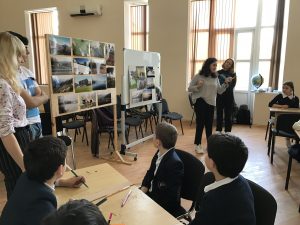
If I had to describe my teaching experience in Sukhum with one word it would be: Improvising. First thing that comes to my mind is the language barrier. Even if I had a translator with me, during the lessons he was often helping our Swiss teachers to communicate with the original teachers of our classes. So I found myself often interacting with both the pupils and my classmates in a gestic or mimic way. Even I think we have to prepare better for the language barrier in Switzerland I am still kind of thankful for this experience. It shoed me that language is not just about speaking but includes a lot more and which makes it possible to communicate even without the language. Second is that we couldn’t see the school before our first class teaching. That made it difficult for us to know what we can expect from the school, the pupils and the lessons. We also didn’t know about the age and the time of classes a few days before. So we had to break down our project to a certain minimum so that it was possible to work with it in this circumstances. Even if it made me a bit sad that we had to deal pretty superficial with our topic and maybe created some stereotypical view on Switzerland it was a decision we had to make in order to keep our interest in the topic of the art bridge. Also other points like loosing our classroom spontaneously or classes that didn’t bring their crayons for some reasons required fast decisions and improvising from our team. I am really happy how it worked out and that despite all the problems we faced we grew together as a group where everyone had their influence and importance.
Pupils from Sukhum/i
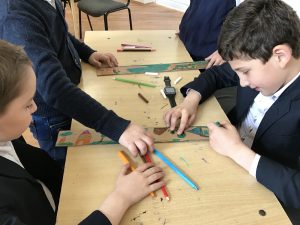
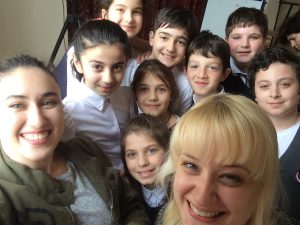
What surprised me a lot where the pupils themselves in school 10. They were very interested, open and hard working in our classes. Even though we needed some time to learn how to best work with them in order to keep them focused, I felt that they were really enjoying their lessons with us. Also their feedback ”DA” (their answer on if they liked the lesson) or the photos and autographs they wanted at the end to the lessons strengthen this feeling. Even if it became more clear to me, that in the future I want to work with older students, I am really thankful for this experiences. Never before had I considered to teach pupils of the age from 7-11 years, but I can now understand what good sides it has. What I liked the most about the pupils, were the moments when they couldn’t tell the difference between Sukhum/i and Zurich anymore or created steps, figures and drawing that were mixing our inputs in the lessons and created something new.
Way Home
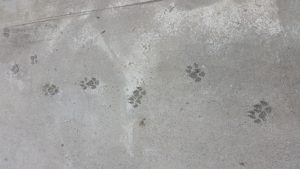
Now back home I am still thinking a lot about my time in the Caucasus. Not only the teaching, but also the place and the people we met, make me reflect a lot about myself, my school and my home country. I hope that I somehow also left some trace in this places or in people I have met in this time. Hopefully all of them can come to Zürich and have a great time here. I am looking forward to the ideas they bring for the school in Bülach, and to the time we will spend and work together. See you in September!
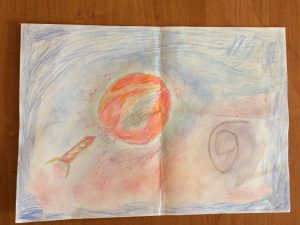
Out of many different materials, such as found objects or scrap, we created an installation in the classroom. The installation should illustrate a phantasy cosmos. With this phantasy cosmos we wanted to stimulate the fantasy and the creativity of the pupils. We wanted them to invent new planets, or an own world.
Many pupils needed some time to get involved. We tought each class just for 45 minutes. But it was very nice that some pupils came back to us a few days after the class and brought their drawings. They had continued drawing at home.
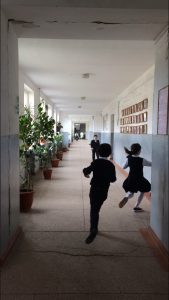
I’ve got the impression that the pupils like to go to school. That’s the main thing.
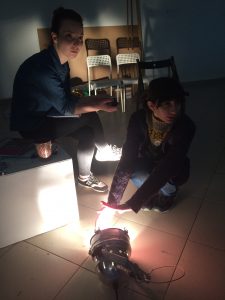
We (ZHdK students) are all art educators and pursue an ideal. What we we pursue and strive for is often not yet a reality in Swiss primary schools. When looking at the reality in Sukhum/i schools, we should not forget that.
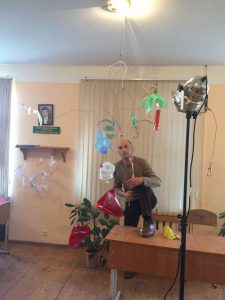
On the first day we started with the lesson we had planned. The art teacher of the school criticized our lesson. The next day, we integrated a topic of the art teacher. In the afternoon of the second day, the art teacher integrated our input in his lesson. On the third day, we again were able to react to his input. This meant we had a constant exchange with him during the whole week, which was very interesting and mutually instructive.
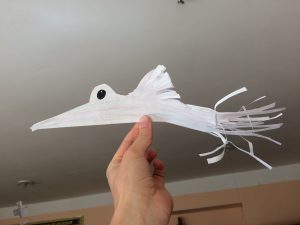
Whistling with the pupils. On the first day we created paper-birds with the students. At the end of the lesson, each student held his bird and walked around the room whistling with his bird. Throughout the day we heard students whistling in the school.
School number 6. The school was on the outskirts of Sukum/i, situated on the main road, only 50 meters back from the coastline. Not far away, a derelict railway station, built in 1950s grandeur, sleeps, as loud engines and dusty cars speed pass. School begins at 8:30 and has 5 classes for primary school pupils, 6 classes for secondary school pupils. A lesson has duration of 45 minutes, with intermissions of 10 – 20 minutes to break, rush to the next class, or eat. In the courtyard that we see on the photo here, parents catch up on the news, as they wait to collect their sons and daughters.
Primary schools in Sukum/i seem to be structured in a traditional, authoritative way. Here, the pupils are encouraged to copy the teacher exactly, with litle room for personal interpretation. While a show/copy strategy can be effective in specific contexts, in Switzerland we don’t often use this pedagogic style in art classes. This photograph shows pupils, who present their uniform landscape to us, their guests.
In short concession, sounds collected from around Sukhum/i were played to the class. This exercise was aimed at shaking the student’s idea of drawing perfectly, or just drawing objects. Instead, it should encourage them to draw out of intuition, and to think about how the sound was made – the movement that made the sound. on the drawing depicted here, the pupil translated four different sounds in four different ways. This kind of outcome was very encouraging for us, because it meant the pupil had understood our instruction and had experimented.
After playing a variety of short sounds, that we had recorded from the urban environment of Sukhum/i, the students were asked to take out a new blank piece of paper, and this time they were instructed to listen to a longer sequence. This longer sequence had a narrative structure: There were two characters, firstly a woman walking down some stairs outside, with birds chirping in the background, the opening of a door, turning on a washing machine and feeding her cat. The second character, the cat, can be heard in the background, as she enters the laundry room and then again meowing in thanks, when she receives her food. The students were asked to draw what they had heard as they had heard it.
See the photo for example: Like many of his fellow pupils, this pupil of about 7 years had focused on drawing the sound elements as objects, such as tree leaves, the cat and a washing machine. However, this pupil also had understood from our previous presentations, that representing movement in the drawing was a further possibility for translating sound. Here this pupil drew dashes and circles in what we can read as beeps from the washing machine turning on, as well as water starting to flow, and the cat food falling into its dish. This pupil was able to merge two different interpretations of sound in one drawing.
This drawing indicated that the child had learned what we had hoped it would learn, namely incorporating elements of sound – tone, movement, rhythm, volume – into a drawing. Instead of just drawing the object creating the sound, this young participant drew not only what he saw in his mind – the train as an object – but also the sound originating from the train tracks, the wheels and the carriages.
© 2026 Art Matters
Theme by Anders Noren — Up ↑